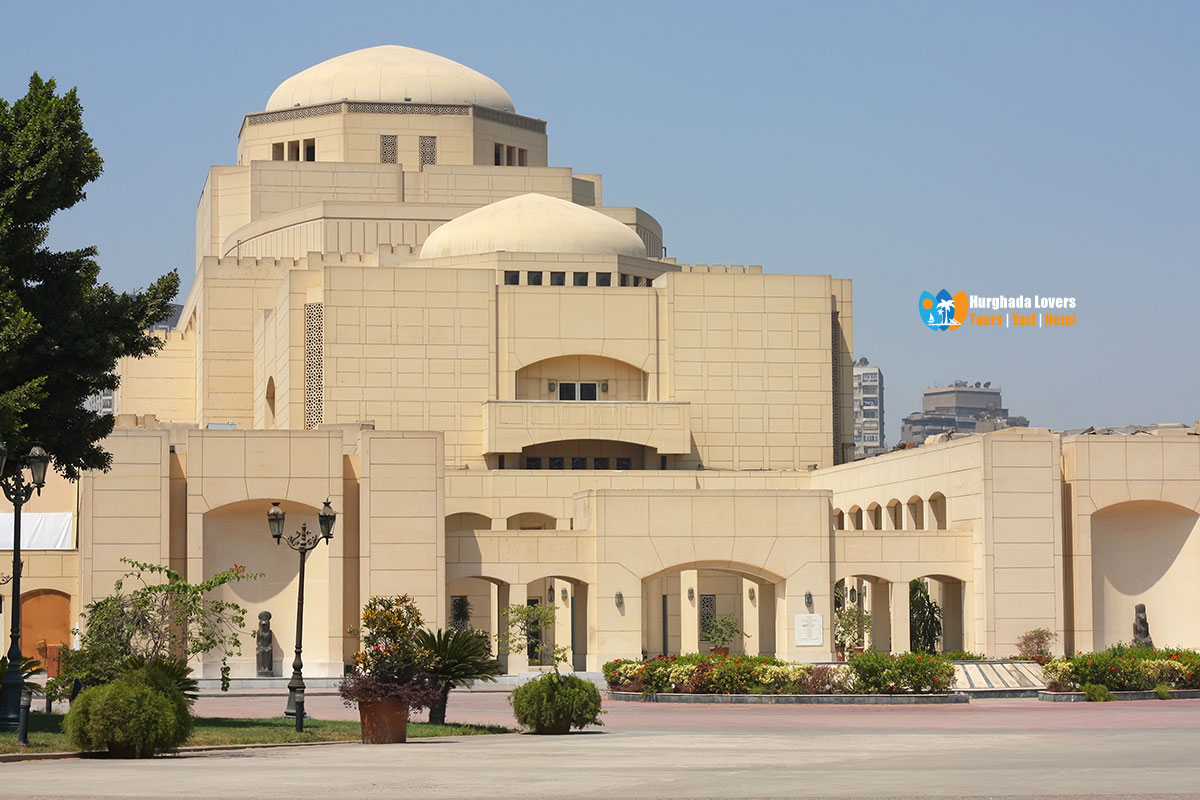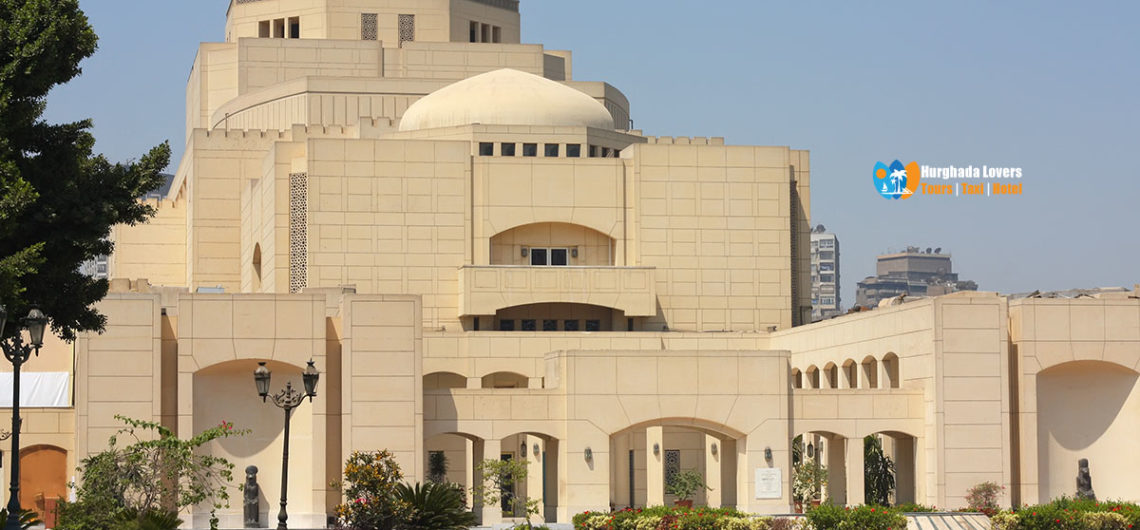Cairo Opera House | History of the construction of the G General Authority for National Cultural Center – best Things to Do in Cairo Egypt.
Learn about the Talent Development Center, theaters, cultural centers, concerts’ schedules, house shows, entry ticket prices, and more to start your inspirational touristic trip to Things to Do in Egypt.
The Cairo Opera House is considered one of the most important Cairo landmarks that tourists can visit, as it includes many historical and archaeological halls that you will enjoy discovering.
Hurghada lovers Offer Luxury Hurghada to Pyramids Tours | El Gouna to Pyramids Tours | Makadi bay to Pyramids Tours | Sahl Hasheesh to Pyramids Tours | Soma bay to Pyramids Tours .
Theaters and cultural centers, Cairo Opera House:
El Hanager Arts Center:It includes an exhibition hall and a small theater for free performances.
The Music Library: it houses an art exhibition hall.
Theater of Artistic creativity center: it’s an affiliate of the Egyptian Ministry of Culture.
Museum of Modern Egyptian Art
The grand theater hall: Dedicated for large opera and musical performances at a capacity of 1200 seats.
The small theater hall: is dedicated for seminars, cultural evenings, as well as small and informal artistic performances at a capacity of about 500 seats.
The open-air theater: Dedicated to summer and youth performances at a capacity of about 60 seats, and many local and international shows have been held on it.
Egypt’s Fine Arts Syndicate
Arts Palace: A large center offering facilities for art-related events such as exhibitions, seminars, films, and performances.
You can visit the Opera Museum on the first floor. The museum is designed in two wings. The first wing is devoted to documents relating the history of the Royal Cairo Opera House, and the second one is dedicated to the New Cairo Opera House and it includes catalogues and posters of performances presented by the National Cultural Center.
In the second wing, you will see a huge Nay (oriental flute) with a length of 2.17 meters and a diameter of up to 10 cm, which is made of ornamented wood decorated with shells, in addition to watching a rare piano and some costumes donated to the New Cairo Opera House by the Vienna State Opera in Austria. Moreover you will also find an anthropomorphic model of the New Opera House buildings and photos while it was under construction.
You can visit the Music Library, which has been designed into 4 halls (the reading room, a special audiovisual room dedicated for video presentations, the Audio hall, and the hall including manuscripts about the achievements of the Arabic heritage of music).
The library has been provided with a rare collection of music tracks from around the world in the form of discs, video tapes and cassettes, in addition to Arabic and foreign books, tabloids, newspapers, light slides, and kits for artistic performances presented by theaters at the National Cultural Center.
You can visit the Art Gallery Hall daily (except Fridays) from 10 am to 2 pm and then from 4.30 pm to 8.30 pm.
The Art Gallery was established on an area of 120 meters for each floor level. All sections and halls of the opera are monitored with highest quality surveillance cameras.
All the artistic activities held at the gallery are recorded on video tapes to be archived at the Music Library for educational and cultural purposes.
Since the inauguration of the Cairo Opera House, the Art Gallery has been an active venue for many important exhibitions and events like the Annual Exhibition for the International Photography Competition (Holland) and the Egyptian Plastic Art Pioneers Exhibition representing the different art schools in Egypt.
Thus, the gallery complements the International Plastic Art Movement and contributes to bridging the gap between western and Ancient Egypt art. The Arabic Calligraphy Exhibition is another significant annual event held there
Additionally, the gallery is an important venue for international biennials, triennials, festivals, cultural weeks and other events taking place at the Cairo Opera House such as the Egyptian-Italian Year Celebration and the International Women’s Day.
The National Cultural Center was developed and restored, including an exhibition hall, dressing rooms, special rooms for artists, rehearsals halls, training rooms, a restaurant, a library and a museum to display the history of the Egyptian Opera House, some training classes and fashion workshops.
The Talent Center:
The administration was interested in establishing a special center for talent development in children to enrich and develop their performance. In April 1992 AD, the following was established:
- A class to teach the art of playing the piano from the age of 10 until the age of 20.
- A Studio to discover talents from the age of 16.
- Ballet classes from 6 to 11 year olds.
- A class for teaching operatic choral starting from the age of 6 years to 11 years.
- A class to teach the violin starting the age of 4 years, also known as the Suzuki art.
- A class to teach Playing Arabic and Oriental Instruments.
- A class to teach him the musical notes, known as the Solfege Center.
History of the Khedivial (Royal) Opera House in Egypt:
The opera art goes back to the history of the History Of Egyptian, especially the development of the Harp instrument, which was developed from the Pharaohs era until it became the eastern lute (Oud) in our time.
The Khedivial (Royal) Opera House in Egypt
The opera house was built on the orders of the Khedive Ismail to celebrate the opening of the Suez Canal where it was named “Khedivial Opera House. The architects Pietro Avoscani (from Livorno) and Rossi designed the building based on the Italian style. It was made mostly of wood and is filled with interior decorations and engravings.
The Khedive Ismail selected Mariette Pasha to prepare a story about the Egyptian history that could form the nucleus of the poem play. Mariette Pasha commissioned the Italian poem Gialanzoni to write the libretto, and the musician Verdi was commissioned by the Khedive to compose the music. The result was the famous Opera Aida, with its patriotic subject and passionate song and superb music, a masterpiece from the hands of these three geniuses.
The Opera House was inaugurated in November 1869 AD at the Rigoletto show, and the opening time coincided with the celebrations of the Suez Canal. Unfortunately, the Egyptian Opera House in October 1971 completely burned down, leaving only the statue of prosperity and the statue of Renaissance of Arts.
The history of the construction of the old opera house dates back to the prosperity period that Egypt experienced during the era of Khedive Ismail in all fields.
The Opera House was located between the districts of Azbakeya in central Cairo which is Egypt’s capital city.
At the opening ceremony of the Egyptian Opera House, Khedive Ismail invited a large number of European kings and queens, and the opera was built within only six months after its design was developed by the Italian architects Avoscani and Ross.
Khedive Ismail’s desire was heading towards an Egyptian opera with which to open the Khedive Opera House, and the opera Aida, whose music was set by the Italian composer Verdi, but circumstances prevented it from being presented at the time on the opening ceremony, so the Italian opera Rigoletto was presented at the official opening attended by Khedive Ismail and Empress Eugenie, Napoleon’s wife (Napoleon the Third), King of Austria and Crown Prince of Prussia.
The Cairo Opera House in the present era
It was opened during reign of former President Mohamed Hosni Mubarak on October 10, 1988 AD, after it was closed for 17 years.
In October 1988, the Opera House was inaugurated in the presence of former President Hosni Mubarak and His Imperial royal Highness Prince Tomohito of Mikasa.
The new Cairo Opera was built in cooperation with the Japan International Cooperation Agency (JICA) in coordination with the Egyptian Ministry of Culture.
Its design is characterized by the Islamic style, as the construction area includes 22,772 square meters, while the building itself is located on an area of 13,855 square meters, with a height of 42 meters.
The site of the Cairo Opera House is distinguished by its uniqueness, as it is located in the southern part of the Gezira area and is surrounded by water on all sides, which means that the abundance of Nile water in this area leads to the abundance of trees in the garden surrounding the Opera House.
Japan participated in the kabuki show at the opening of the National Cultural Center, for a 50-member troupe.
Local bands performances at the Cairo Opera House:
· Cairo Symphony Orchestra
· Abdel Halim Nouira Ensemble for Arabic Music · Alexandria Opera Troupe For Arabic Music & Singing |
Visiting dates to the Egyptian Opera House.
You can visit the opera house at any time depending on the event you are attending.
Ticket prices: Tickets’ prices vary depending on the concerts
Opera house address: Al-Tahrir Street, Al-Jazira Tower – Zamalek, Cairo, P.O.Box: 11567 Al-Jazirah Tower
Website link: You can visit the official website of the Cairo Opera House and learn about the annual performance programs for this year and more PLACES TO VISIT IN CAIRO, GIZA EGYPT.
Author & Writer Cairo Opera House: Tamer Ahmed Abd elfatah Yousif


